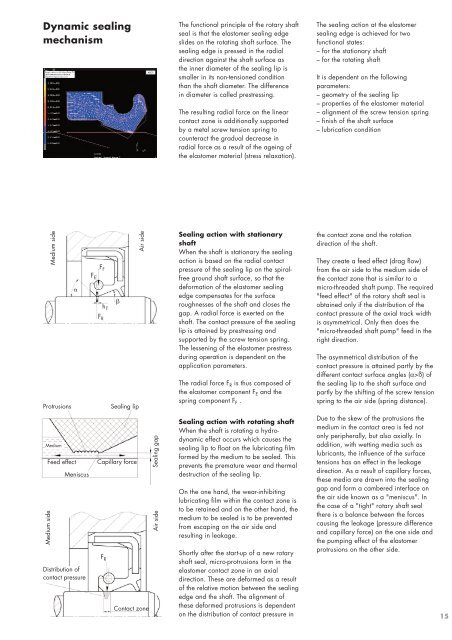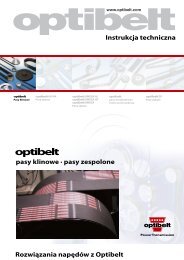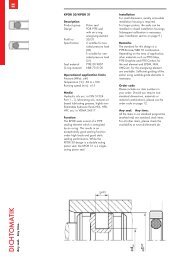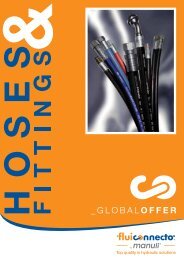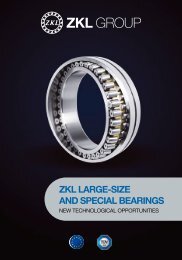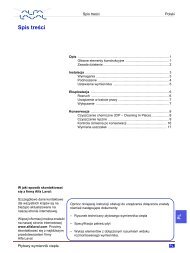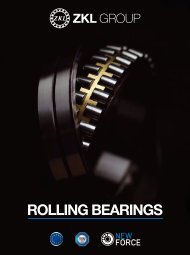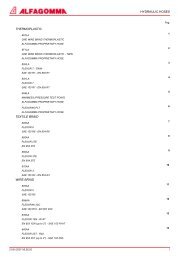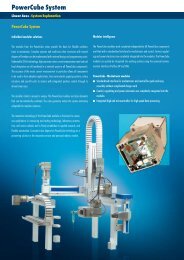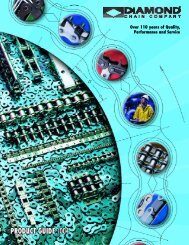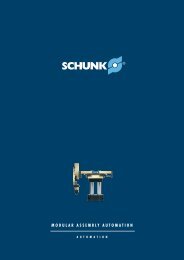DICHTOMATIK
DICHTOMATIK - Spinet
DICHTOMATIK - Spinet
- No tags were found...
You also want an ePaper? Increase the reach of your titles
YUMPU automatically turns print PDFs into web optimized ePapers that Google loves.
Dynamic sealing<br />
mechanism<br />
The functional principle of the rotary shaft<br />
seal is that the elastomer sealing edge<br />
slides on the rotating shaft surface. The<br />
sealing edge is pressed in the radial<br />
direction against the shaft surface as<br />
the inner diameter of the sealing lip is<br />
smaller in its non-tensioned condition<br />
than the shaft diameter. The difference<br />
in diameter is called prestressing.<br />
The resulting radial force on the linear<br />
contact zone is additionally supported<br />
by a metal screw tension spring to<br />
counteract the gradual decrease in<br />
radial force as a result of the ageing of<br />
the elastomer material (stress relaxation).<br />
The sealing action at the elastomer<br />
sealing edge is achieved for two<br />
functional states:<br />
– for the stationary shaft<br />
– for the rotating shaft<br />
It is dependent on the following<br />
parameters:<br />
– geometry of the sealing lip<br />
– properties of the elastomer material<br />
– alignment of the screw tension spring<br />
– finish of the shaft surface<br />
– lubrication condition<br />
Medium side<br />
Protrusions<br />
<br />
F E<br />
F F<br />
F R<br />
h f<br />
<br />
Sealing lip<br />
Air side<br />
Sealing action with stationary<br />
shaft<br />
When the shaft is stationary the sealing<br />
action is based on the radial contact<br />
pressure of the sealing lip on the spiralfree<br />
ground shaft surface, so that the<br />
deformation of the elastomer sealing<br />
edge compensates for the surface<br />
roughnesses of the shaft and closes the<br />
gap. A radial force is exerted on the<br />
shaft. The contact pressure of the sealing<br />
lip is attained by prestressing and<br />
supported by the screw tension spring.<br />
The lessening of the elastomer prestress<br />
during operation is dependent on the<br />
application parameters.<br />
The radial force F R is thus composed of<br />
the elastomer component F E and the<br />
spring component F F .<br />
the contact zone and the rotation<br />
direction of the shaft.<br />
They create a feed effect (drag flow)<br />
from the air side to the medium side of<br />
the contact zone that is similar to a<br />
micro-threaded shaft pump. The required<br />
"feed effect" of the rotary shaft seal is<br />
obtained only if the distribution of the<br />
contact pressure of the axial track width<br />
is asymmetrical. Only then does the<br />
"micro-threaded shaft pump" feed in the<br />
right direction.<br />
The asymmetrical distribution of the<br />
contact pressure is attained partly by the<br />
different contact surface angles (α>ß) of<br />
the sealing lip to the shaft surface and<br />
partly by the shifting of the screw tension<br />
spring to the air side (spring distance).<br />
Medium<br />
Medium side<br />
Feed effect<br />
Meniscus<br />
Distribution of<br />
contact pressure<br />
Capillary force<br />
F R<br />
Contact zone<br />
Sealing gap<br />
Air side<br />
Sealing action with rotating shaft<br />
When the shaft is rotating a hydrodynamic<br />
effect occurs which causes the<br />
sealing lip to float on the lubricating film<br />
formed by the medium to be sealed. This<br />
prevents the premature wear and thermal<br />
destruction of the sealing lip.<br />
On the one hand, the wear-inhibiting<br />
lubricating film within the contact zone is<br />
to be retained and on the other hand, the<br />
medium to be sealed is to be prevented<br />
from escaping on the air side and<br />
resulting in leakage.<br />
Shortly after the start-up of a new rotary<br />
shaft seal, micro-protrusions form in the<br />
elastomer contact zone in an axial<br />
direction. These are deformed as a result<br />
of the relative motion between the sealing<br />
edge and the shaft. The alignment of<br />
these deformed protrusions is dependent<br />
on the distribution of contact pressure in<br />
Due to the skew of the protrusions the<br />
medium in the contact area is fed not<br />
only peripherally, but also axially. In<br />
addition, with wetting media such as<br />
lubricants, the influence of the surface<br />
tensions has an effect in the leakage<br />
direction. As a result of capillary forces,<br />
these media are drawn into the sealing<br />
gap and form a cambered interface on<br />
the air side known as a "meniscus". In<br />
the case of a "tight" rotary shaft seal<br />
there is a balance between the forces<br />
causing the leakage (pressure difference<br />
and capillary force) on the one side and<br />
the pumping effect of the elastomer<br />
protrusions on the other side.<br />
15


